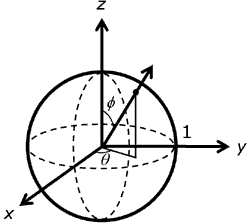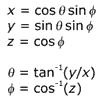Evaluates a spherical light and returns spectral spherical harmonic (SH) data.
HRESULT D3DXSHEvalSphericalLight( UINT Order, CONST D3DXVECTOR3 * pPos, FLOAT Radius, FLOAT RIntensity, FLOAT GIntensity, FLOAT BIntensity, FLOAT * pROut, FLOAT * pGOut, FLOAT * pBOut );
If the function succeeds, the return value is D3D_OK. If the function fails, the return value can be: D3DERR_INVALIDCALL.
Evaluates a spherical light and returns spectral SH data. There is no normalization of the intensity of the light like there is for directional lights, so care has to be taken when specifying the intensities. This will compute three spectral samples; pROut will be returned, while pGOut and pBOut may be returned.
On the sphere with unit radius as shown, direction can be specified simply with theta, the angle about the z-axis in the right-handed direction, and phi, the angle from z.

The following equations show the relationship between Cartesian (x, y, z) and spherical (theta, phi) coordinates on the unit sphere. The angle theta varies over the range of 0 to 2 pi, while phi varies from 0 to pi.

Header: Declared in D3dx9math.h.